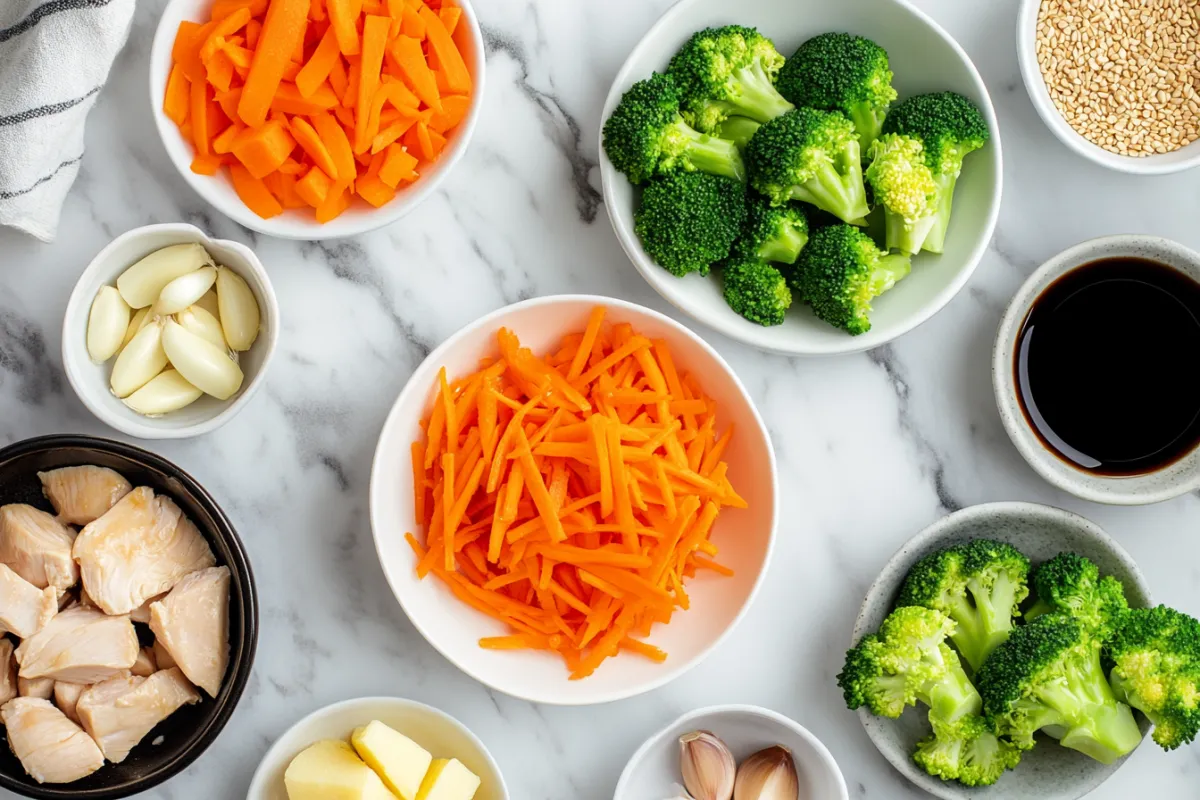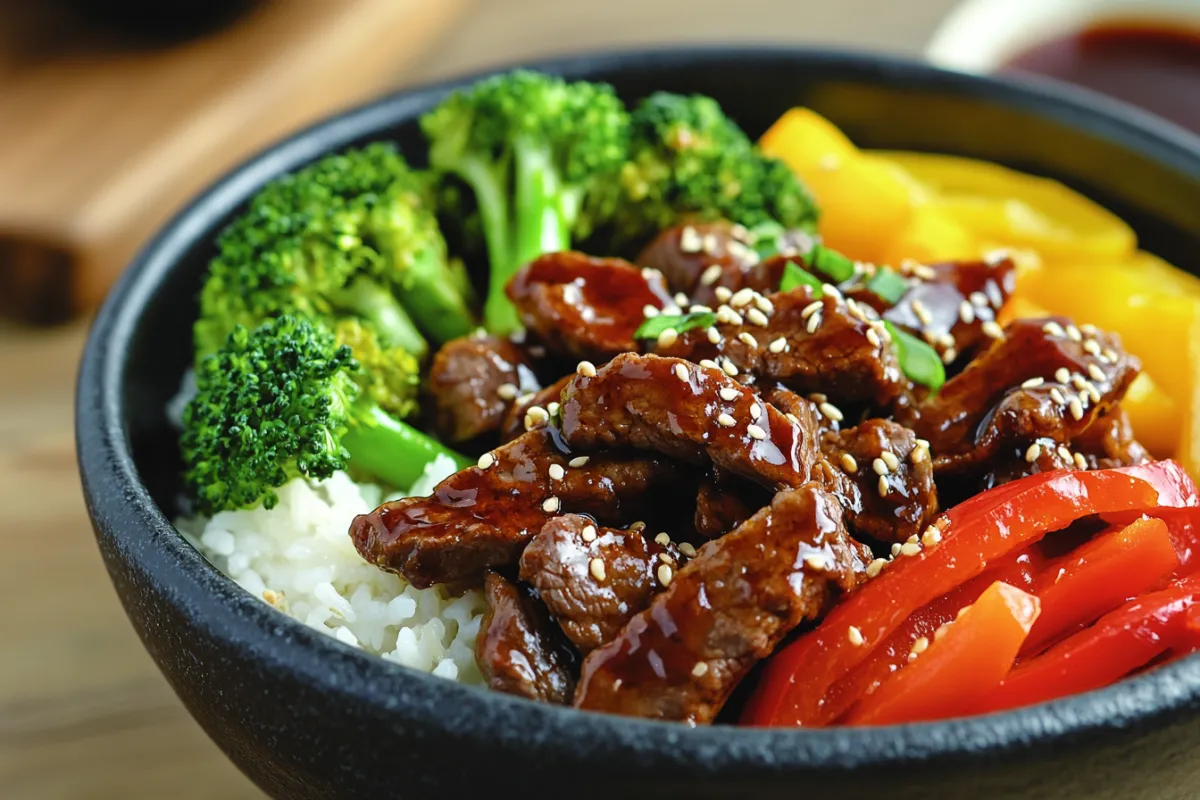Teriyaki bowls have gained immense popularity around the world for their delightful balance of sweet and savory flavors. Combining perfectly cooked proteins, fresh vegetables, and a rich teriyaki sauce over rice, this dish offers a versatile and wholesome meal. Whether you prefer chicken, beef, tofu, or shrimp, the teriyaki bowl can easily be customized to suit your taste preferences. In this comprehensive guide, we’ll walk you through everything you need to know about crafting the ultimate teriyaki bowl from scratch, including tips for making the best sauce, choosing the right ingredients, and creating exciting variations.
What is a Teriyaki Bowl?
Teriyaki, a Japanese cooking technique, refers to grilling or broiling foods that are basted in a savory-sweet sauce made from a base of soy sauce, mirin (sweet rice wine), and sugar. While originally hailing from Japan, teriyaki has evolved into an international culinary favorite. In a teriyaki bowl, the sauce is combined with protein, vegetables, and rice, and topped with an extra drizzle of sauce for flavor.
The modern teriyaki bowl has seen many variations. As the dish traveled beyond Japan, cooks began incorporating different proteins and vegetables. You can now find teriyaki bowls made with everything from the traditional chicken and beef to more innovative options like tofu, tempeh, and even fish.
For a deeper understanding of the origins of teriyaki and its influence on international cuisine, you can explore this article on Japanese culinary history.
Evolution of Teriyaki Bowls
Originally, teriyaki was used as a marinade for fish in Japan. Over time, the dish adapted to include various proteins and vegetables, becoming a common staple in many parts of the world, particularly in American cuisine. The dish became synonymous with Japanese-American restaurants and is now a go-to option for many seeking a flavorful yet healthy meal.
Essential Ingredients for a Teriyaki Bowl
Though the ingredients can be tailored to personal preferences, a classic teriyaki bowl includes a few essential components that make it irresistible. These components work together to create a meal that’s not only delicious but also nutritious.
1. Protein
The choice of protein is one of the most important aspects of a teriyaki bowl. Whether you’re using chicken, beef, tofu, shrimp, or even fish, the protein serves as the foundation for the dish. Here’s a closer look at popular protein options:
- Chicken: Chicken is the most popular choice, especially boneless, skinless chicken thighs or breasts. It absorbs the teriyaki sauce well, making it tender and juicy.
- Beef: Thinly sliced sirloin or ribeye works best for beef teriyaki bowls. These cuts of meat sear quickly, providing a crispy exterior and a juicy center.
- Tofu: For a vegetarian option, firm tofu is ideal. Marinating it in teriyaki sauce before pan-frying gives the tofu a golden crust and a flavorful inside.
- Shrimp: Shrimp cooks quickly, making it perfect for a fast dinner. Its natural sweetness pairs beautifully with the savory teriyaki sauce.
2. Vegetables
Vegetables add texture, flavor, and nutritional value to the teriyaki bowl. Commonly used vegetables include:
- Broccoli: Adds a slight bitterness that balances the sweetness of the sauce.
- Carrots: Their crunchy texture and sweet flavor work well with the other elements of the dish.
- Bell Peppers: Bright and slightly tangy, bell peppers add a burst of color and flavor.
- Zucchini: A soft vegetable that absorbs the flavors of the teriyaki sauce.
Other vegetables like spinach, mushrooms, snap peas, or even edamame can be added for extra variety.
3. Rice
Rice is the most common base for teriyaki bowls. The most popular choices include:
- White Rice: Fluffy and slightly sticky, white rice is the traditional choice.
- Brown Rice: For a healthier, fiber-rich option, brown rice is a great substitute.
- Cauliflower Rice: A low-carb alternative for those looking to reduce calorie intake.
- Quinoa: Another healthy, protein-rich alternative that adds an interesting texture to the dish.
4. Teriyaki Sauce
The star of the dish is undoubtedly the teriyaki sauce. This sauce is what ties everything together, providing a rich, sweet, and savory glaze for the ingredients. While store-bought versions are convenient, making your own teriyaki sauce at home allows you to control the flavor profile and ensure it’s perfectly tailored to your taste.
How to Make Teriyaki Sauce from Scratch
The beauty of teriyaki sauce lies in its simplicity. You only need a few key ingredients to create a deeply flavorful sauce.

Ingredients for Teriyaki Sauce:
- Soy sauce: The salty base of the sauce that provides the signature umami flavor.
- Mirin: Adds sweetness and depth.
- Sake (optional): A traditional Japanese rice wine that adds complexity to the sauce.
- Sugar or honey: Balances the saltiness of the soy sauce with a touch of sweetness.
- Garlic and ginger: Fresh aromatics that bring out the rich flavors of the sauce.
Step-by-Step Recipe:
- In a saucepan, combine 1 cup of soy sauce, ¼ cup of mirin, and ¼ cup of sake.
- Add 2 tablespoons of sugar or honey, 2 minced garlic cloves, and 1 tablespoon of grated ginger.
- Heat the mixture over medium heat, stirring until the sugar dissolves.
- Let the sauce simmer for 5-10 minutes until it thickens slightly.
- Remove from heat and let it cool. The sauce will thicken further as it cools.
Tip: You can store this homemade sauce in an airtight container in the refrigerator for up to two weeks.
Protein Options for Teriyaki Bowls
The choice of protein plays a significant role in defining the texture and flavor of your teriyaki bowl. Each protein option absorbs the teriyaki sauce differently, creating unique variations of the dish.
1. Chicken Teriyaki
Marinate chicken in teriyaki sauce for at least 30 minutes before grilling or stir-frying to ensure that the meat absorbs the sauce’s flavors deeply. For the juiciest result, use boneless, skinless chicken thighs or breasts. Grilled chicken will have a smoky flavor, while stir-fried chicken will be more tender.
2. Beef Teriyaki

Choose tender cuts of beef, such as sirloin or ribeye, and slice them thinly to allow for quick cooking. Sear the beef over high heat to create a crispy exterior while keeping the inside juicy.
3. Tofu Teriyaki
Tofu is the perfect vegetarian alternative for teriyaki bowls. Firm tofu holds its shape best during cooking. Press it to remove excess moisture before marinating in teriyaki sauce. Pan-fry it for a golden, crispy exterior.
4. Shrimp Teriyaki
Shrimp cooks very quickly, making it ideal for a fast teriyaki meal. Simply toss the shrimp in teriyaki sauce before stir-frying for 2-3 minutes until they turn pink.
Vegetables for Teriyaki Bowls
Vegetables add vibrant color, texture, and nutrition to teriyaki bowls. The crisp texture of the vegetables contrasts beautifully with the tender protein and fluffy rice. Below are some commonly used vegetables and their characteristics.
1. Broccoli
The slight bitterness of broccoli complements the sweetness of the teriyaki sauce. Steaming or stir-frying broccoli ensures it retains its crunch.
2. Carrots
Thinly sliced or shredded carrots add a refreshing crunch and natural sweetness to your bowl.
3. Bell Peppers
Bell peppers provide a pop of color and a fresh, slightly tangy flavor. Both red and yellow bell peppers work well in this dish.
4. Zucchini
Zucchini’s mild flavor absorbs the teriyaki sauce well, and its soft texture blends perfectly with the tender protein.
Other vegetables like mushrooms, snap peas, and spinach can also be added for more variety.
Step-by-Step Guide to Making a Classic Teriyaki Chicken Bowl
Ingredients:
- 2 boneless, skinless chicken breasts, diced
- 2 cups cooked white rice
- 1 cup steamed broccoli
- 1 carrot, shredded
- 1 batch of homemade teriyaki sauce
- Sesame seeds and green onions for garnish
Directions:
- In a large pan, heat 1 tablespoon of oil over medium-high heat.
- Add the diced chicken and cook until browned on all sides, about 5-7 minutes.
- Pour the teriyaki sauce over the chicken and simmer until the sauce thickens and coats the chicken, about 3-4 minutes.
- Assemble the bowl by placing a scoop of rice at the bottom. Top with the cooked chicken, steamed broccoli, and shredded carrot.
- Garnish with sesame seeds and sliced green onions before serving.
Customizing Your Teriyaki Bowl
The beauty of a teriyaki bowl is its versatility. You can easily adjust the flavors, ingredients, and presentation to suit your preferences. Here are a few ideas to inspire your next creation:
Spicy Teriyaki Bowl
If you like a little heat, add sriracha or red pepper flakes to the teriyaki sauce. The spiciness complements the sweetness of the sauce, creating a balanced, flavorful dish.
Pineapple Teriyaki Bowl
For a tropical twist, add pineapple chunks or mix pineapple juice into the teriyaki sauce. The sweetness of the pineapple works wonderfully with the savory sauce.
Low-Carb Teriyaki Bowl
Replace the rice with cauliflower rice to reduce carbs while keeping the dish filling and flavorful.
Noodle Teriyaki Bowl
Swap out the rice for udon or ramen noodles for a delicious noodle-based version of the dish.
Meal Prep and Storage Tips
Teriyaki bowls are excellent for meal prep because they store well and maintain their flavor for several days. Here are some tips for preparing teriyaki bowls in advance:
- Prepare the ingredients separately: Cook and store the rice, protein, vegetables, and sauce in separate containers.
- Reheat properly: When you’re ready to eat, reheat the protein and veggies in a pan or microwave before assembling the bowl.
- Store the sauce separately: This prevents the dish from becoming soggy. Drizzle the sauce over the bowl right before serving.
Popular Teriyaki Bowl Pairings
To elevate your teriyaki bowl experience, consider pairing it with some complementary side dishes:
- Edamame: Lightly salted and steamed, edamame makes for a healthy and tasty side.
- Miso Soup: A warm bowl of miso soup pairs perfectly with the savory flavors of the teriyaki bowl.
- Ginger Lemonade: A refreshing drink to balance the rich and savory flavors of the teriyaki sauce.
FAQs
1. Can you use store-bought teriyaki sauce?
Yes, store-bought teriyaki sauce works well in a pinch. However, homemade sauce allows you to control the sweetness and saltiness to suit your taste.
2. How do I store leftover teriyaki bowls?
Store the components of the teriyaki bowl separately in airtight containers. Reheat the protein and vegetables before serving.
3. Can I freeze teriyaki bowls?
Yes, you can freeze the cooked protein and rice. However, it’s best to prepare fresh vegetables when ready to eat. Frozen teriyaki bowls can be stored for up to two months.
4. What can I use instead of soy sauce for a gluten-free version?
For a gluten-free alternative, you can substitute soy sauce with tamari or coconut aminos.
A teriyaki bowl is the perfect combination of flavor, nutrition, and customization. Whether you’re making it for a quick weeknight dinner or meal prepping for the week ahead, teriyaki bowls offer endless possibilities. You can adjust the ingredients and flavors to create a dish that’s uniquely yours, and with a homemade teriyaki sauce, you can elevate the meal to a restaurant-quality experience right in your kitchen. Try out different variations and make this versatile dish a staple in your meal rotation!
For more delicious recipes, don’t forget to explore our homepage at Cheery Recipes!

